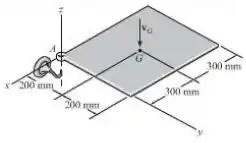A placa fina uniforme tem uma massa de , imediatamente antes de seu canto acertar o gancho, ela está caindo com uma velocidade sem movimento rotacional. Determine sua velocidade angular logo após o canto acertar o gancho sem repicar.

Passo 1
Oi pessoal, tudo bem? Vamos analisar essa questão.
Por definição, temos que:
Temos também que:
Passo 2
Podemos aplicar a conservação da quantidade de movimento angular:
Para o segudo momento, vamos analisar as componentes:
Em
Em
Em
Agora que sabemos as componentes, temos:
Resolvendo, temos:
Logo: